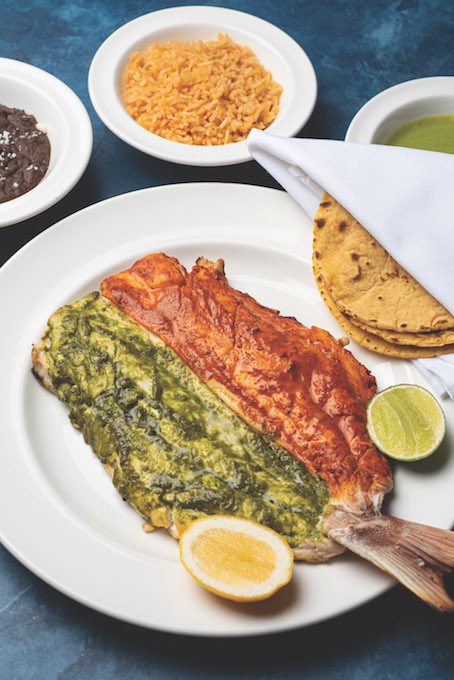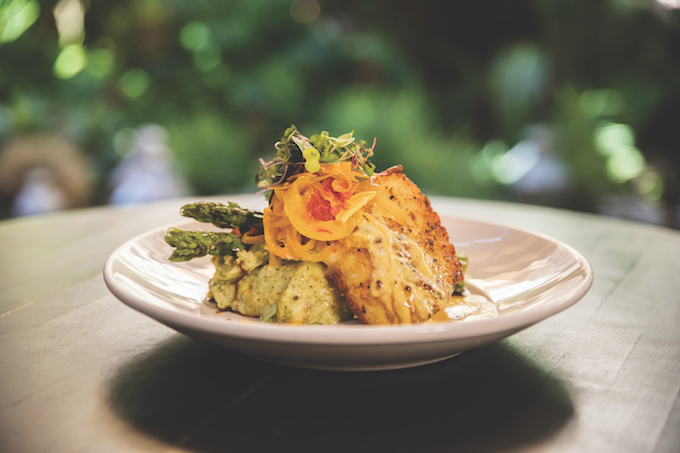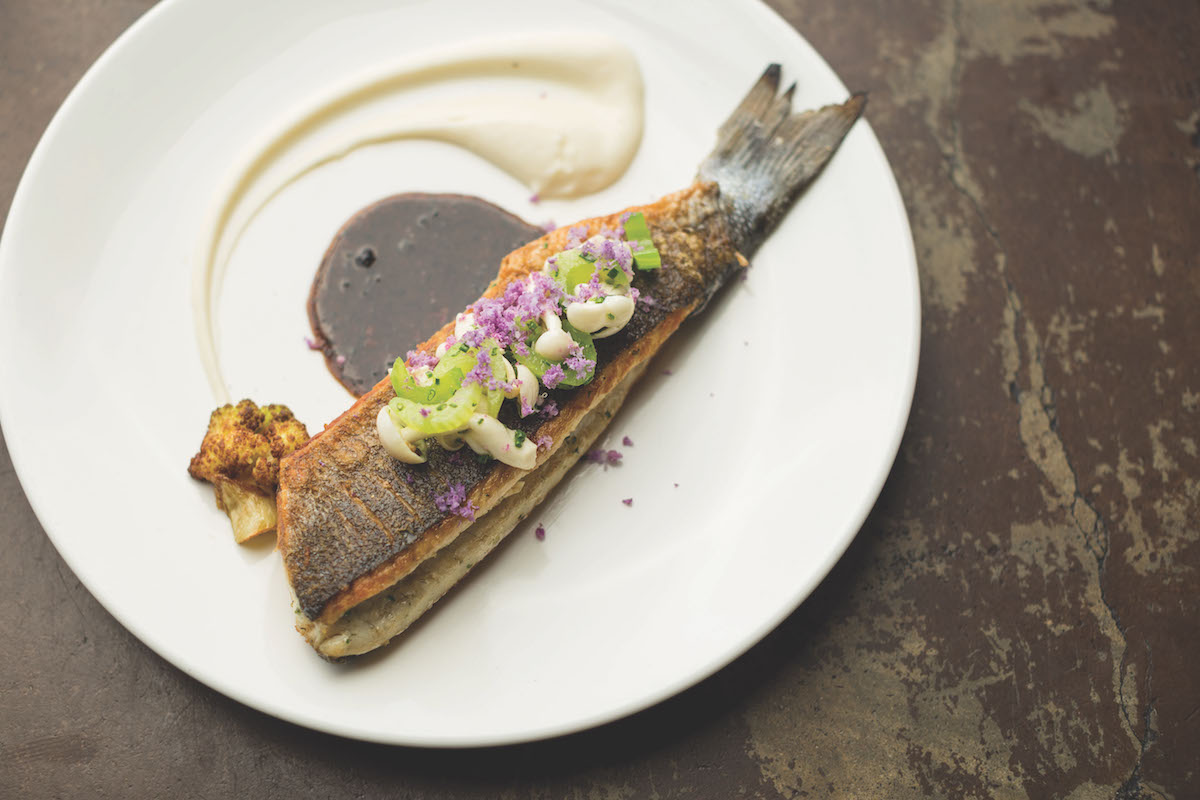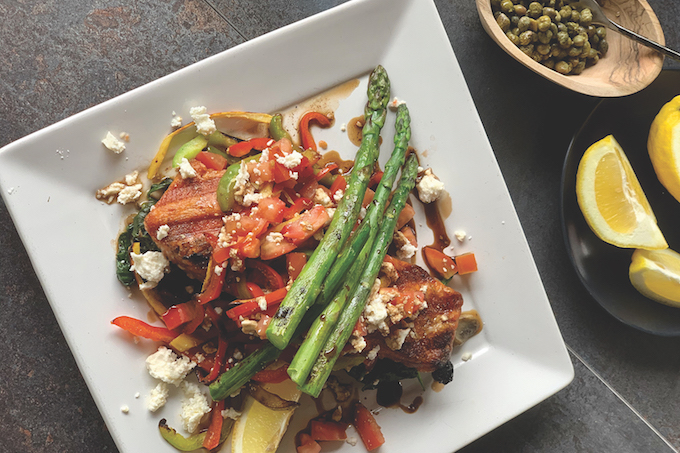
Local chefs create fish dishes with around-the-world influences.
By Tanya A. Yacina
One of the perks of living in a beachside town is the abundance of fresh fish dishes from which to choose at local restaurants. Seasonal selections combine with each chef’s personal flair to create mouthwatering options—and many are globally inspired with special seasonings or preparations that elevate an everyday dish to multicultural cuisine—and you don’t even have to leave Laguna to enjoy it.
“For me, travel always inspires my cooking. When I have time, I love visiting new countries and cities [and going to their] … local spots to see what people are eating,” says Amar Santana, executive chef and owner of Broadway by Amar Santana. “The best places to find new ideas is finding a family-run spot. Flavor is everything; plating and technique is secondary.”
Las Brisas Executive Chef Christopher Lin adds that it all comes down to the quality of a recipe’s components and methods used, adding that he tries to “keep it simple, but with complex flavor combinations.”
“Traditionally, fish dishes come from all walks of life,” Lin says. “It is important to understand sustainability and use ingredients from your region while using well-executed cooking techniques to create a beautiful dish. There are many different techniques, from searing to poaching to wrapping in banana leaves. Sauces are only as great as the seasonality of the available ingredients.”
Flavorful Traditions
“Almost all of our dishes are globally influenced. We utilize traditions from France, Italy, Spain, Morocco and more,” says Santana, noting that one of his favorite menu items is the herb-roasted Mediterranean branzino. Simple and flavorful, it has been on Broadway’s menu the longest.
“Originally, upon opening, I wanted to do a 5-pound, whole catfish on the menu. Everyone told me I was crazy and sourcing quality catfish consistently was a little more difficult than expected,” he says. “We did a whole branzino instead and we sell so many of that dish [that] I’ve lost count.”

Broadway’s pan-roasted, boneless Mediterranean branzino is stuffed with herbs and the tail is retained. Served with cauliflower puree, truffle sauce, pickled clamshell mushrooms, fresh celery truffle oil and roasted green cauliflower, the entire dish is topped with shaved purple cauliflower for a pop of color that makes a beautiful garnish.
Lin recommends the Contramar on the “For Two” section of Las Brisas’ menu as a great entree to share.
“Depending on the season, we use a Thai snapper or a local red snapper. It is grilled and presented butterflied with red sauce and green sauce on each side of the filet. It is accompanied at the table with fresh-pressed corn tortillas, rice and beans,” Lin says. “Our green and red sauces that cover either side of the snapper makes for [a] great symphony of flavors.
This is a traditional dish created by chef Gabriela Cámara for her Mexico City restaurant. “We pay tribute to her and her idea of bringing people together,” Lin says. “This dish was designed to bring people together because, whether guests prefer green sauce or red sauce, it is a crowd-pleaser at the table.”
Cultural Cuisine
Moving across the globe to another continent for inspiration, Starfish Laguna Beach offers patrons an Asian perspective on fish preparation in several of its dishes, including the wild Thai halibut, which is prepared with Thai herbs and spices, steamed in banana leaf and served with coconut rice, macadamia nuts, creamy chile-basil sauce and flour tortillas. A grilled option, Starfish also serves white miso black cod with misoyaki sauce, roasted sweet yam, green and yellow squash and sauteed enoki mushrooms.

For some African flavor, Mozambique presents one of its staple menu items: the Chilean sea bass. The 10-ounce filet is seasoned with Moroccan spices, served with an assortment of artichokes, fennel, tomatoes and asparagus, as well as pesto mashed potatoes and a beurre blanc saffron sauce.
And for a taste of Italy, head to Oliver’s Osteria in Laguna Canyon, which wows taste buds with salmone alla puttanesca—grilled salmon coupled with black olives, capers and tomato sauce.
The options are seemingly endless: From Catfish Gumbo at Roux Creole Cuisine to chipotle-dusted sea bass at South of Nick’s and Mediterranean king salmon—complete with feta cheese, balsamic glaze and veggies—at GG’s Bistro, it’s truly a journey for the senses.
Tips and Tricks
No matter the locale inspiring a fish dish, there are some basic techniques to keep in mind for the best results.
“Fish has a wide range of presentations, flavor profiles and textures,” Lin says. “While salmon is fatty and has a great flavor profile, sea bass can be fatty and flaky on the palate. I enjoy a seared Chilean sea bass with nothing other than grilled lemon to complement it. Keeping it simple and to the point can really highlight an ingredient’s profile.”
Lin encourages diners and home cooks to be adventurous and try different types of fish, whether it be a freshwater or ocean species. But when choosing a fish to prepare, Lin says to look for what is sustainable, fresh and in season—key for high-quality ingredients.
Santana agrees that the best kind of fish is what’s available during that particular season. He recommends bringing a high-quality fish to room temperature before cooking and to have grapeseed oil and fresh herbs and spices on hand to create the perfect dish.
“I use a French technique—searing fish in grapeseed oil to get [the] skin super crispy; it has a higher smoke point,” Santana explains.

Lin says searing or grilling is always a great way to prepare fish, and that salt and pepper are underestimated in his book. Salt brings out rich oils and pepper gives a little punch to wake up the palate. He advises cooking fish on one side 85% to 90% of the way through, then flip to complete the cooking process. Lin also says citrus, herbs and a little fat will never do you wrong in creating a fish dish.
“Nothing better than a classic beurre blanc with wine, butter, lemon juice, shallots and a little salt,” Lin adds. “It is acidic, yet buttery—you can’t go wrong with this sauce to accommodate any type of cooked fish.”
“Once the fish I’ve seared in oil [is] cooked halfway, I love basting with butter—I realize that’s not very healthy,” Santana says. “To me, I’d rather have it full of flavor, so basting with butter and any aromatic herbs helps to add to the flavor of the fish and makes you not want to stop eating it.”
